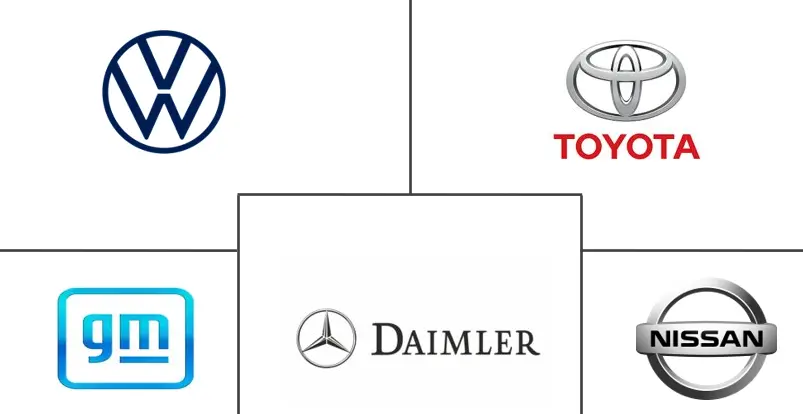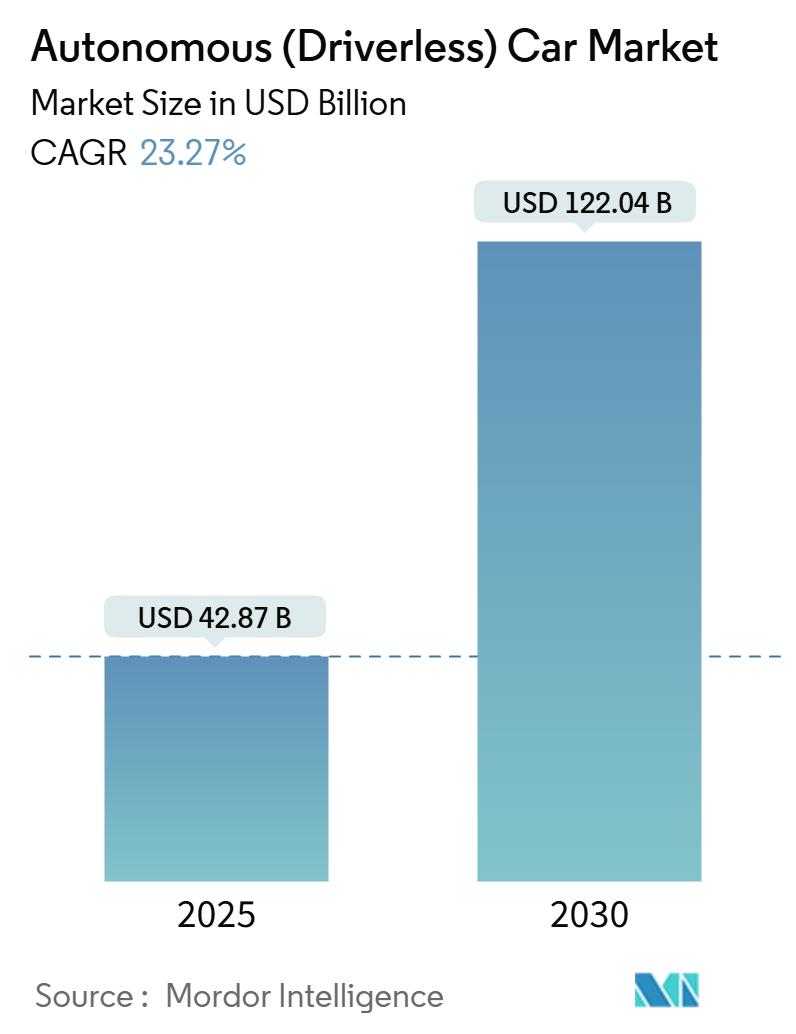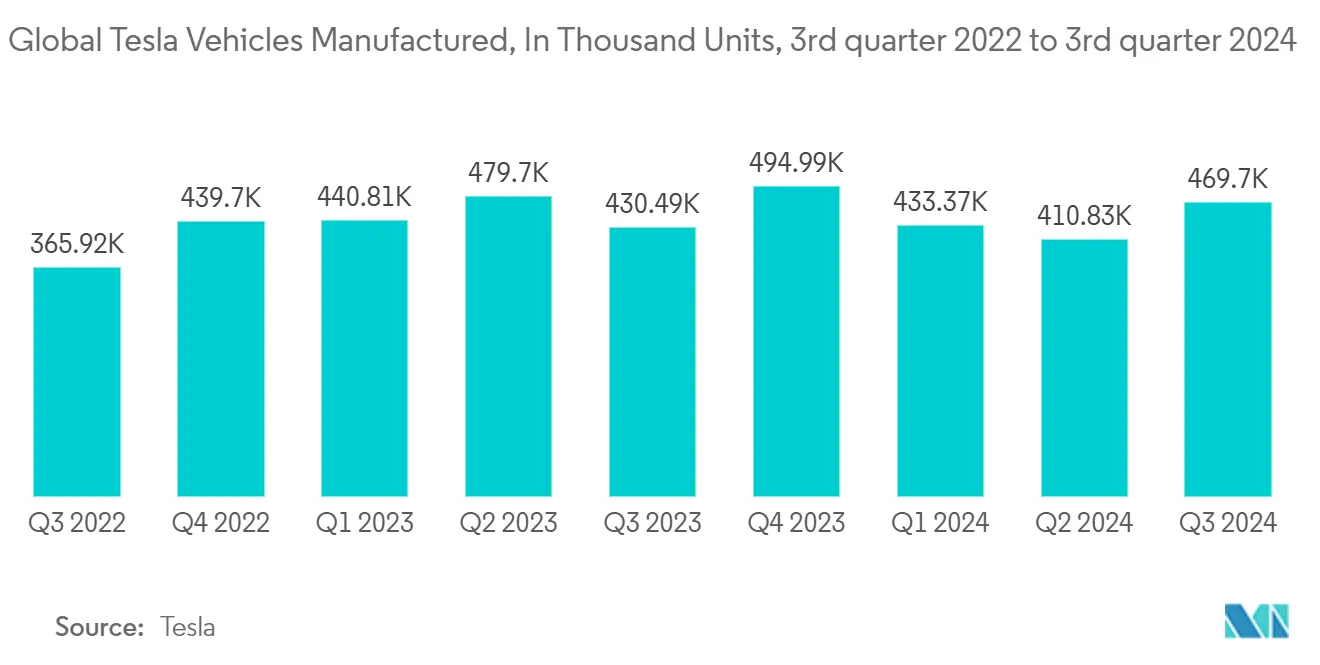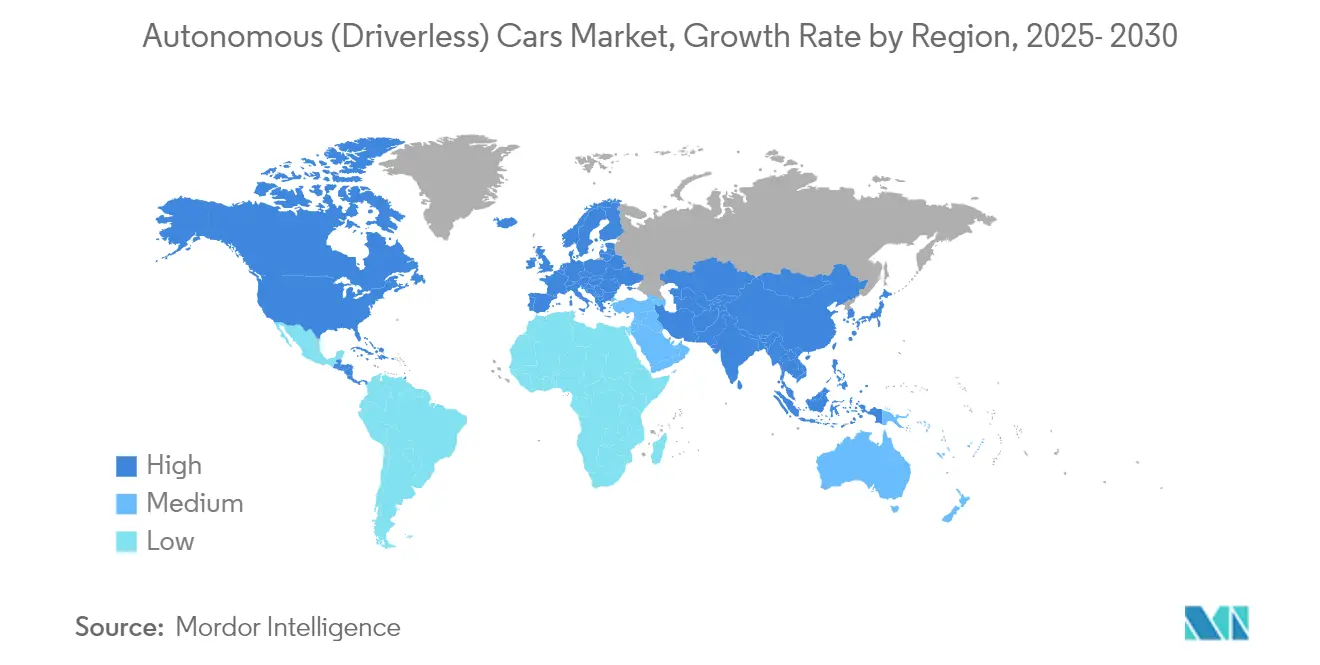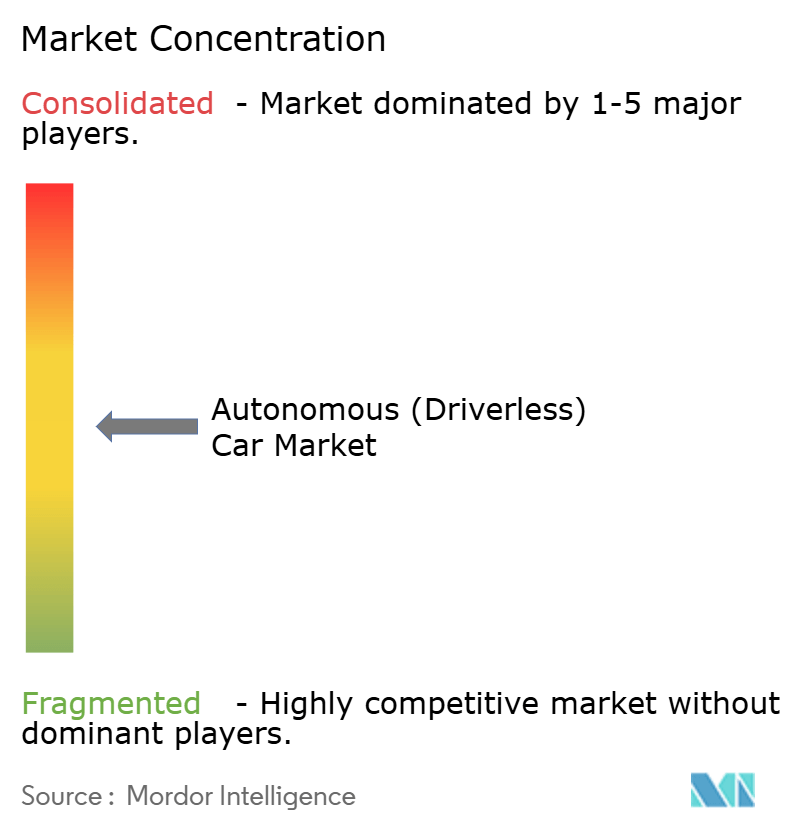Autonomous (Driverless) Car Market Analysis
The Autonomous Car Market size is estimated at USD 42.87 billion in 2025, and is expected to reach USD 122.04 billion by 2030, at a CAGR of 23.27% during the forecast period (2025-2030).
The autonomous vehicle market is on the brink of revolutionizing transportation by significantly reducing human errors. These vehicles aim to enhance road safety, save lives, and optimize traffic flow. Beyond these benefits, they are set to redefine urban mobility, lower greenhouse gas emissions, and contribute to sustainability goals. As urbanization accelerates and traffic congestion worsens alongside a growing global population, the automotive industry's substantial investments in autonomous technology highlight the pressing need for innovative transportation solutions.
Advances in sensor technologies, including LiDAR, radar, and cameras, have led to the development of highly accurate perception systems for autonomous vehicles. Presently, Level 2 and Level 3 cars dominate the market, however, by 2030, Levels 4 and 5 (as per SAE's scale) are set to gain traction. According to a forecast by Goldman Sachs, Level 3 vehicles could represent up to 10% of global new car sales, while Level 4 cars may account for 2.5% by 2030. The growing dominance of Levels 2 and 3 is set to drive market expansion. With the backing of advancements in artificial intelligence and machine learning, these vehicles are becoming adept at navigating intricate environments and making swift, accurate decisions.
Autonomous vehicles offer significant potential, but their development faces numerous challenges. A major concern is ensuring these vehicles can safely and reliably operate alongside traditional cars on the road. Establishing regulatory frameworks and standardization is critical for their testing, certification, and deployment. To tackle these issues, many governments are actively supporting the technology by providing R&D funding, creating testing environments, and updating existing laws. At the same time, Original Equipment Manufacturers (OEMs) are heavily investing in R&D to enhance the safety, reliability, and cost-efficiency of autonomous vehicles. Their partnerships with tech companies, startups, and research institutions are driving further innovation in the field. However, stringent government oversight and federal regulations continue to pose significant challenges for companies aiming to deploy autonomous or self-driving technologies.
North America is anticipated to lead the autonomous vehicle market, followed by Asia-Pacific and Europe. In North America, key automotive manufacturers, technology leaders, and emerging startups are heavily investing in autonomous technologies. Simultaneously, countries like China, Japan, India, and South Korea are experiencing increasing demand for self-driving cars, positioning the Asia-Pacific region for remarkable growth in the coming years.
The autonomous vehicle sector is set to play a key role in smart city initiatives, aiming to improve urban mobility and ease traffic congestion. This development emphasizes the increasing integration of autonomous vehicles in public transportation, such as buses and taxis. Moreover, the growing adoption of advanced driver-assistance systems (ADAS) in conventional vehicles is anticipated to enhance safety and comfort while fostering the acceptance of fully autonomous vehicles. The progressive adoption of autonomous driving technology in the ride-hailing industry is also expected to strengthen the market outlook in the coming years.
Autonomous (Driverless) Car Market Trends
Semi-Autonomous Cars Expected to Drive Significant Advancements During the Forecast Period
Road traffic collisions have caused severe global repercussions in recent years, emphasizing the urgent need for innovative solutions. According to the World Health Organization (WHO), these crashes result in approximately 1.19 million deaths annually, along with 20 to 50 million non-fatal injuries. Vulnerable road users, including pedestrians, cyclists, and motorcyclists, account for more than half of these incidents. The economic impact is significant, burdening individuals, families, and nations with high healthcare costs and lost productivity. These collisions consume about 3% of a nation's gross domestic product, highlighting the necessity for effective interventions.
Semi-autonomous cars, classified as Level 2 or Level 3, provide a safer and more efficient driving experience, making them a viable option for reducing accidents. These vehicles automate complex tasks such as lane centering, adaptive cruise control, and parking, enabling drivers to focus more effectively on the road. Furthermore, this technology improves accessibility for individuals with disabilities and those with limited driving skills, expanding its usability across diverse demographics.
Advancements in automotive technology, fueled by artificial intelligence (AI), have led to the development of more advanced Advanced Driver-Assistance Systems (ADAS). These systems enable automakers to design vehicles that can autonomously perform a growing number of driving tasks, significantly enhancing the driving experience. Additionally, the increasing demand for safer and more efficient vehicles, along with rising traffic congestion in urban areas, has driven greater interest in semi-autonomous cars as a practical solution. In April 2024, the Association for Computing Machinery urged policymakers to reconsider the assumption that "fully automated vehicles will inevitably reduce road injuries and fatalities." This perspective could influence consumers to prefer semi-autonomous vehicles instead.
The semi-autonomous car sector is experiencing rapid advancements and notable launches worldwide. Tesla's Autopilot has set a high standard in the industry, enabling vehicles to maintain lane positioning, adjust speeds, and change lanes with minimal driver intervention. General Motors' Super Cruise allows hands-free driving on divided highways, while Audi's Traffic Jam Pilot autonomously handles driving in slow traffic, with speeds capped at 40 km/h (25 mph). In addition to these leading players, numerous startups and established automotive companies are heavily investing in research and development to introduce innovative semi-autonomous technologies. These efforts include progress in LiDAR, radar, and camera systems, alongside the integration of machine learning algorithms and improved safety features. For instance,
- In June 2024, BMW became the first automaker globally to gain approval for combining a Level 2 driving assistance system (BMW Highway Assistant) with a Level 3 system (BMW Personal Pilot L3) in a single vehicle.
- In March 2024, the Insurance Institute for Highway Safety (IIHS) carried out a comprehensive evaluation of Tesla's autonomous features, focusing on the safety and performance of its Autopilot and Full Self-Driving (FSD) systems.
- In March 2024, Xiaomi debuted its first electric vehicle, the SU7, in China, tagging it with a price of 215,900 yuan (approximately USD 30,408).
The semi-autonomous car sector is anticipated to become a key component of the transportation industry, with significant growth expected in the coming years.
North America Likely to Hold Dominant Share in the Market
North America dominates the global autonomous (driverless) car market, thanks to its strong automotive sector and the presence of tech giants like Google, Microsoft, and Apple. In the U.S., states like California, Texas, and Arizona have begun trials and limited deployments of self-driving cars. Currently restricted to specific test zones and driving conditions, these vehicles hold promise for easing traffic congestion and addressing environmental issues through reduced emissions and a commitment to clean energy. However, General Motors' recent closure of its Cruise robotaxi business, coupled with a probe into Tesla's "Full Self-Driving" systems after multiple accidents, poses challenges to the region's dominance in the autonomous car market.
North America's autonomous car landscape is bustling with activity. Industry stalwarts like Tesla, Volkswagen, and Nissan are heavily investing in the race towards fully autonomous vehicles. For instance,
- In April 2024, Uber Eats and Waymo, leveraging Waymo's cutting-edge self-driving technology, rolled out autonomous deliveries in Phoenix, Arizona, marking a significant step towards more efficient and eco-friendly services.
- In March 2024, Waymo, the autonomous arm of Alphabet Inc., commenced tests for its fully autonomous vehicles in Austin, Texas. This strategic move not only expands Waymo's operational footprint but also enhances data collection for future urban deployments. The tests, conducted using Waymo's Chrysler Pacifica Hybrid minivans, feature top-tier sensors and advanced AI capabilities.
- In February 2024, Apple made headlines in the self-driving arena, announcing plans for a 2024 launch of its much-anticipated "Apple Car." This electric vehicle featured advanced autonomous capabilities, developed through Apple's substantial investments in R&D, strategic collaborations, and acquisitions of key technology patents. Experts believed the Apple Car had the potential to redefine transportation standards with its innovative technology and eco-friendly features.
Autonomous (Driverless) Car Industry Overview
The autonomous vehicle market is experiencing significant growth, driven by increasing collaborations among traditional automakers and tech companies specializing in hardware and software. This rising interest has spurred a wave of partnerships, investments, and joint ventures in the autonomous driving sector.
- In September 2024, WeRide, a global leader in autonomous driving technology, partnered with Uber Technologies, Inc. to bring WeRide's autonomous vehicles to the Uber platform, starting in the UAE.
- In August 2024, Uber Technologies, Inc. entered a multi-year strategic alliance with Cruise. Their joint venture aims to integrate Cruise's autonomous vehicles into the Uber platform, with plans to launch next year using a fleet centered around the Chevy Bolt model.
- In July 2024, Uber announced a collaboration with BYD, targeting the creation of "autonomous-capable vehicles" and the introduction of 100,000 electric vehicles to its ride-hailing service.
- In February 2024, Nissan introduced a next-generation electric vehicle platform designed to support its upcoming electric models. This advanced platform emphasizes improved driving performance, enhanced safety features, and sustainability. Additionally, Nissan plans to launch its autonomous-drive mobility services in Japan by the end of 2027.
Autonomous (Driverless) Car Market Leaders
-
Volkswagen AG
-
Toyota Motor Corporation
-
General Motors Company
-
Nissan Motor Co., Ltd.
-
Daimler AG (Mercedes-Benz Group)
- *Disclaimer: Major Players sorted in no particular order
Autonomous (Driverless) Car Market News
- January 2025: Uber Technologies, Inc. and NVIDIA have teamed up to bolster the development of AI-driven autonomous driving technology. This collaboration melds Uber's vast data reservoir with NVIDIA's advanced Cosmos platform and DGX Cloud, empowering autonomous vehicle partners to craft a robust AI model.
- November 2024: Baidu, a major player from China, has secured a license to trial its Apollo Go robotaxi service in Hong Kong, marking its expansion beyond the Chinese mainland. The license, valid from December 9, 2024, to December 8, 2029, permits trials for 10 autonomous vehicles in North Lantau.
- November 2024: Lyft is forging several partnerships to seamlessly integrate autonomous vehicle (AV) rides into its app. In a bid to broaden its audience, Lyft plans to incorporate Mobileye-equipped vehicles, streamlining access for fleet operators and enhancing AV fleet optimization.
- June 2024: Toyota, in collaboration with state-owned Guangzhou Automobile Group, is set to debut an electric car boasting an advanced autonomous driving system akin to Tesla's Full Self-Driving, targeting the Chinese market by 2025. This strategic move aims to reclaim Toyota's dwindling market share in China, aligning with local competitors on pivotal technologies like hybrids, batteries, and smart vehicles.
Autonomous/Driverless Car Industry Segmentation
Autonomous vehicles, also known as self-driving cars, are transforming modern transportation. These vehicles leverage advanced technologies such as artificial intelligence, sensors, and machine learning to function without human intervention. They are capable of navigating roads, making decisions, and executing complex driving tasks autonomously. Their key benefits include enhanced safety, improved efficiency, and increased sustainability in transportation. With the potential to revolutionize the transportation sector, self-driving cars aim to ease traffic congestion and lower the occurrence of road accidents. In the future, autonomous vehicles are expected to redefine mobility, reshape urban environments, and meet diverse transportation demands.
Autonomous/Driverless Car Market Covers Segmentation Based On Type and Geography. By type, the market is segmented into semi-autonomous vehicles and fully autonomous vehicles. By geography, the market is segmented into North America, Europe, Asia-Pacific, and the Rest of the World. For each segment, market sizing and forecast have been done based on value (USD).
| Type | Semi-Autonomous Vehicles |
| Fully Autonomous Vehicles | |
| Geography | North America |
| Europe | |
| Asia Pacific | |
| Rest of the World |
Autonomous (Driverless) Car Market Research Faqs
How big is the Autonomous Car Market?
The Autonomous Car Market size is expected to reach USD 42.87 billion in 2025 and grow at a CAGR of 23.27% to reach USD 122.04 billion by 2030.
What is the current Autonomous Car Market size?
In 2025, the Autonomous Car Market size is expected to reach USD 42.87 billion.
Who are the key players in Autonomous Car Market?
Volkswagen AG, Toyota Motor Corporation, General Motors Company, Nissan Motor Co., Ltd. and Daimler AG (Mercedes-Benz Group) are the major companies operating in the Autonomous Car Market.
Which is the fastest growing region in Autonomous Car Market?
Asia-Pacific is estimated to grow at the highest CAGR over the forecast period (2025-2030).
Which region has the biggest share in Autonomous Car Market?
In 2025, the North America accounts for the largest market share in Autonomous Car Market.
What years does this Autonomous Car Market cover, and what was the market size in 2024?
In 2024, the Autonomous Car Market size was estimated at USD 32.89 billion. The report covers the Autonomous Car Market historical market size for years: 2020, 2021, 2022, 2023 and 2024. The report also forecasts the Autonomous Car Market size for years: 2025, 2026, 2027, 2028, 2029 and 2030.
Our Best Selling Reports
Autonomous (Driverless) Car Industry Report
The autonomous vehicle market is experiencing significant technological advancements, focusing on improving road safety and smartphone integration. Currently, Level 2 and Level 3 driverless cars dominate, but Level 4 and Level 5 vehicles are expected to gain wider acceptance. North America is a key player, with substantial investment in robotic car technology, while the Asia-Pacific region is seeing growth in demand for unmanned vehicles. The industry is moderately consolidated, with increased partnerships and investments towards developing driverless vehicle technology.
The autonomous vehicles market is witnessing remarkable growth, propelled by technological advancements and a surge in demand for safer, more efficient transportation. With self-driving cars statistics highlighting rapid expansion, the market size is set to soar, particularly with AI-based camera systems enhancing safety features like adaptive cruise control and automated braking. This not only improves road safety but also paves the way for robo-taxis and shared mobility services, creating lucrative opportunities despite challenges such as high component costs and infrastructural deficits in emerging markets.
The shift towards shared and service-based transportation models is evident, with the Asia Pacific region leading the charge through strategic partnerships and investments. The autonomous vehicles market size, fueled by innovation, government backing, and evolving consumer preferences towards autonomous and shared mobility, promises significant growth.
For detailed insights, Mordor Intelligence™ offers a comprehensive analysis, including a market forecast, growth rate, and a free report PDF download, encapsulating the autonomous vehicles market's potential. The report example highlights market trends and market growth, providing an industry overview and market analysis. The market report also includes market segmentation and industry statistics, offering a market outlook and market overview. The industry report is enriched with market data and market predictions, ensuring that market leaders can make informed decisions. The market value and market review further detail the industry's trajectory, making it an essential resource for research companies.

